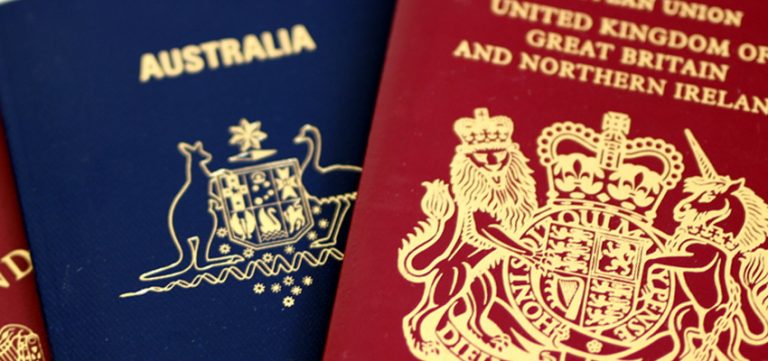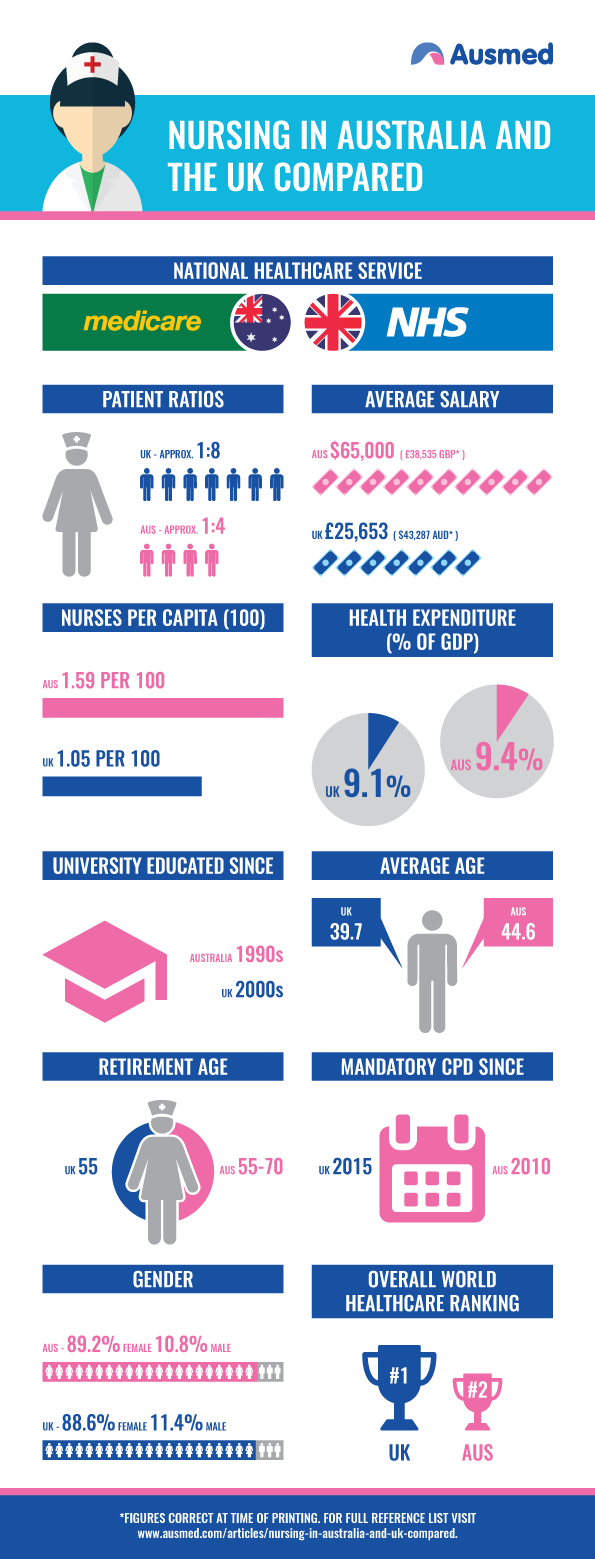With Ausmed recently becoming an Associate Member of the Commonwealth Nurses and Midwives Federation, we thought this would be a great opportunity to compare nursing in Australia and the UK.
Nursing in Australia and the UK Compared
Working in the UK is a common occurrence for Australian nurses, likewise UK nurses working in Australia. The similarities in healthcare models, employment opportunities, cost of living and language has meant that migrating between the two countries for nurses and midwives is simple, and often welcomed.
With Ausmed recently becoming an Associate Member of the Commonwealth Nurses and Midwives Federation, we thought this would be a great opportunity to compare nursing in Australia and the UK and see where each country varied in several categories – from average yearly salary to age, gender and overall global healthcare ranking.
National Healthcare Service
The National Health Service (NHS) in the UK was a major point of contention in this year’s general election, with questions being asked about funding, wages and even the potential for privatising the NHS on the table.
The NHS differs from Australia’s Medicare most significantly in how healthcare is paid for. Under the Australian system, practitioners are paid at the point of care per consultation, while the NHS has a system of capitation payments.
Medicare is a universal, government-controlled service and financed by a levied percentage of the population’s tax. Healthcare in Australia is also supplemented with private providers whose services are usually partly covered by Medicare.
In the UK, the NHS differs slightly between England, Scotland, Wales and Northern Ireland. Generally, the public is able to access free healthcare from GPs and some other services. The NHS is publicly funded through taxation and, though private providers exist, they are not funded by the NHS. (19)
Patient Ratios
In general, the UK has a nurse-patient ratio of 1:8 (1), however, the Royal College of Nursing in their Guidance on Safe Nurse Staffing Levels in the UK, provide several different recommendations for staffing levels, based on the place of work, location, number of beds, etc. (20)
Australia nurse-patient ratio, on average, is 1 nurse to 4 patients, except during night duty. (2)
Average Salary
Registered nurses on average earn £25,653 (3) ($42,535) in the UK and $65,000 (4) (£39,201) in Australia (note, numbers vary by band/tier, position, private/public workplace, location etc. )
Population and Total Number of Nurses
Despite having a much larger population of 65,648,054, (7) the United Kingdom has comparatively fewer nurses than Australia (by percentage), with only 1.05% of the population (690,773) working as nurses (5).
Australia’s nurses make up around 1.6% of the 24,385,600 (8) population (387,888 nurses) (6).
University Education
From September 2013 onwards, all nursing education in the UK was at a degree level, after a period of reform (known as Project 2000) spanning across the 1990s and 2000s seeing nursing education move across from diploma education to a formal degree level. Australia began the transition to bachelor degrees in the 1990s.
The change to university education saw criticism in both countries, with critics believing the move would mean nurses would lack the hands-on experience that hospital-based training had previously offered. (18)
Average Age and Retirement Age
The average age of nurses in Australia is significantly older at 44 (10), compared to nurses in the UK who average at 39 (9). This could be due to the fact that the average retirement age of UK nurses comes at 55 years old (11), whereas Australian nurses are retiring later and later – from anywhere between 55 and 70 years of age (12).
Nurse Gender
The nurse gender differences in Australia and the UK are very similar, at 89.2% (16) and 88.6% female (15), respectively, however, the number of male nurses has seen an increase in recent years (statistics looked at did not account for the countries’ genderqueer/non-binary nurse numbers).
Mandatory Continued Professional Development (CPD)
Australia introduced mandatory continued professional development/education requirements in 2010, with nurses being required to complete a minimum of 20 hours of CPD as part of their yearly registration renewal (14). This change has seen Ausmed’s CPD platform become the leading tool in Australia for nurses and midwives to document and reflect on their CPD requirements, with over 1,000,000 hours of CPD documented since its release in 2016.
In the United Kingdom nurses are required to complete 35 hours of CPD, however, this can be spaced across the three year period since their last registration renewal (13).
Overall World Healthcare Ranking
Though many studies have been conducted on where each country’s overall healthcare models rank on a global scale, the most recent places the UK first, with Australia coming in second (17). Other countries ranked included the Netherlands in third place, New Zealand in fourth and Norway in fifth. The United States was ranked last out of the 11 considered, with the highest rate of mortality.
| UK | AUS | |
| National Healthcare Service | NHS | Medicare |
| Patient Ratios | Approx. 1:81 | Approx. 1:42 |
| Average salary | £25,6533 | $65,0004 |
| Nurses Per Capita | 1.05 per 1005,7 | 1.59 per 1006,8 |
| Health Expenditure (% of GDP) | 9.1%21 | 9.4%21 |
| University educated since | 2000s | 1990s |
| Average age | 39.79 | 44.610 |
| Retirement Age | 5511 | 55-7012 |
| Mandatory CPD Since | 201513 | 201014 |
| Gender | 88.6% Female – 11.4% Male15 | 89.2% Female – 10.8% Male16 |
| Overall World Healthcare Ranking17 | 1 | 2 |
References
- Campbell, D 2015, ‘NHS backtracking on ward nurse numbers introduced after Mid Staffs’, The Guardian, 14 October, viewed 12 September 2017, https://www.theguardian.com/society/2015/…nurse-numbers-introduced-after-mid-staffs
- Australian Nursing & Midwifery Federation, Nurse / Midwife: Patient Ratios, ANMF, viewed 12 September 2017 http://www.anmfvic.asn.au/~/media/f06f12244fbb4522af619e1d5304d71d.ashx
- ndeed 2017, NHS Salaries in the United Kingdom, viewed 12 September 2017, https://www.indeed.co.uk/cmp/Nhs/salaries
- HealthTimes 2017, What do Nurses Earn?, viewed 12 September 2017, https://healthtimes.com.au/hub/nursing-careers/6/guidance/nc1/what-do-nurses-earn/605/
- Nursing & Midwifery Council 2017, The NMC Register, viewed 30 September 2017, https://www.nmc.org.uk/globalassets/sitedocuments/data-reports/the-nmc-register-30-september-2017.pdf
- Nursing and Midwifery Board of Australia, Registrant Data, viewed 12 September 2017, http://www.nursingmidwiferyboard.gov.au/…um=0U7TusRsh2e63OLYZVzl4Q%3d%3d
- Office for National Statistics 2017, Overview of the UK Population: July 2017, viewed 12 September 2017, https://www.ons.gov.uk/peoplepopulationandcommunity/…/articles/overviewoftheukpopulation/july2017
- Australian Bureau of Statistics 2017, 3101.0 – Australian Demographic Statistics, Dec 2016, viewed 12 September 2017, http://www.abs.gov.au/
- NHS Health Education England 2014, Growing Nursing Numbers, viewed 12 September 2017, https://www.hee.nhs.uk/sites/default/files/documents/Nurses%20leaving%20practice%20-%20Literature%20Review.pdf
- Health Workforce Australia 2014, Australia’s Future Health Workforce –Nurses, viewed 12 September 2017, https://www.health.gov.au/internet/main/…ses%20detailed%20report.pdf
- Whitehead, S 2016, ‘The Other NHS Crisis: the Overworked nurses who are leaving in despair’, The Guardian, 25 June, viewed 12 September 2017, https://www.theguardian.com/…rses-who-are-leaving-in-despair
- Australian Nursing & Midwifery Federation 2012, Retirement age for registered nurses , midwives, enrolled nurses and unregulated health care workers (however titled), ANMF, viewed 12 September 2017, https://www.anmfvic.asn.au/~/media/files/anmf/…workers.pdf
- NHS Employers, Revalidation for nurses and midwives, viewed 12 September 2017, http://www.nhsemployers.org/your-workforce/retain-and-improve/…regulation/nursing-revalidation#1
- Ross, K, Barr, J & Stevens, J 2013, ‘Mandatory continuing professional development requirements: what does this mean for Australia nurses, BMC Nurs., viewed 12 Septemeber 2017, https://www.ncbi.nlm.nih.gov/pmc/articles/PMC3618075/
- Williams, R 2017, ‘Why are there so few male nurses?,’ The Guardian, 1 March, viewed 12 September 2017, https://www.theguardian.com/healthcare-network/…why-so-few-male-nurses
- Nursing and Midwifery Board of Australia, Registrant Data, viewed 12 September 2017, http://www.nursingmidwiferyboard.gov.au/documents/…TusRsh2e63OLYZVzl4Q%3d%3d
- The Commonwealth Fund 2017, Mirror Mirror, viewed 12 September 2017, http://www.abc.net.au/news/2017-07-17/australian-healthcare-ranked-…oped-world/8716326
- Bowcott, O 2009, ‘All new nurses to have degrees from 2013’, The Guardian, 13 November, viewed 18 September, https://www.theguardian.com/society/2009/nov/12/nurses-nursing-qualifications-degrees-nmc-rcn
- The Emigration Group 2016, ‘The UK Vs Australia: A Healthcare Comparison’, Emigration News, 25 October, viewed 18 September, http://www.emigrationgroup.com/news/the-uk-vs-australia-a-healthcare-comparison
- Royal College of Nursing 2017, Staffing Levels, viewed 18 September 2017, https://www.rcn.org.uk/get-help/rcn-advice/staffing-levels
- The World Bank 2017, Health expenditure, total (% of GDP), viewed 18 October 2017, https://data.worldbank.org/indicator/SH.XPD.TOTL.ZS?locations=AU-GB
 New
New 
